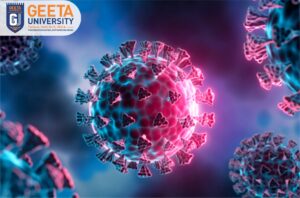NUTRIENT MANAGEMENT – A WAY FORWARD FOR ENHANCING PRODUCTIVITY AND IMPROVING SOIL FERTILITY
UncategorizedNUTRIENT MANAGEMENT – A WAY FORWARD FOR ENHANCING PRODUCTIVITY AND IMPROVING SOIL FERTILITY
- June 27, 2024
- Geeta University
Introduction
Agriculture plays a vital role in global food security, and ensuring sustainable practices is crucial for meeting the increasing demand for food. Integrated Nutrient Management (INM) has emerged as a holistic approach that addresses the challenges associated with conventional nutrient management practices. INM integrates organic and inorganic sources of nutrients to optimize their use, enhance soil fertility, and promote sustainable agricultural practices.Integrated Nutrient Management (INM) is based on several key principles that guide the effective and sustainable management of nutrients in agricultural systems. These principles aim to optimize nutrient use efficiency, enhance soil fertility, and promote environmental sustainability. Below are the fundamental principles of Nutrient Management:
• Rational Nutrient Application: INM emphasizes the need for applying nutrients in a balanced manner, considering the specific requirements of crops at different growth stages. This prevents nutrient imbalances, deficiencies, or excesses that can negatively impact crop health and yield.
• Nutrient Ratios: The principle of balanced nutrient supply involves maintaining appropriate ratios of essential nutrients. Different crops have varying nutrient requirements, and INM ensures that these ratios are met to support optimal growth and development.

Admission Open 2024-2025
For Your bright Future
Integration of Organic and Inorganic Inputs
Organic Sources: INM promotes the use of organic inputs such as compost, manure, crop residues, and green manure. These organic sources contribute to soil organic matter, improve soil structure, and release nutrients gradually, providing a sustained supply throughout the crop cycle.
Inorganic Fertilizers: While organic inputs are crucial for soil health, inorganic fertilizers provide readily available nutrients in specific formulations. INM combines the benefits of both organic and inorganic sources to meet the immediate and long-term nutrient needs of crops.
Soil Health Enhancement
Organic Matter Addition: Increasing soil organic matter content is a key component of INM. Organic matter improves soil structure, water retention, and nutrient availability. It also supports beneficial microbial activity in the soil.
Crop Rotation and Diversification: INM encourages practices like crop rotation and diversification to enhance soil health. Different crops have different nutrient demands, and rotating crops can break pest and disease cycles while optimizing nutrient utilization
Precision Nutrient Management
Site-Specific Nutrient Application: INM involves the application of nutrients in a precise and site-specific manner. This can be achieved through technologies like soil testing, remote sensing, and precision agriculture tools, ensuring that nutrients are applied where and when they are needed most.
Avoiding Wastage: Precision nutrient management helps minimize nutrient wastage, reducing the environmental impact of nutrient runoff and leaching. This is not only economically beneficial for farmers but also promotes sustainability.
Adaptability to Local Conditions
Agro-Climatic Considerations: INM practices need to be adapted to local agro-climatic conditions. Soil types, climate, and crop types vary across regions, and INM strategies should be flexible and tailored to suit the specific needs of each area.
Farmers’ Knowledge and Participation: The success of INM relies on the involvement and knowledge of farmers. Local knowledge and practices should be integrated into nutrient management plans, and farmers should actively participate in decision-making processes.
Continuous Monitoring and Evaluation
Feedback Mechanisms: Regular monitoring and evaluation of nutrient management practices are crucial for assessing their effectiveness. Feedback from the field can guide adjustments to nutrient application strategies based on crop performance, soil health indicators, and environmental impact.
Research and Innovation: Ongoing research and innovation play a vital role in improving INM practices. New technologies and scientific insights can contribute to more efficient nutrient management techniques and better adaptation to changing agricultural and environmental conditions.
Components of Integrated Nutrient Management
Integrated Nutrient Management (INM) involves the judicious integration of various components to optimize nutrient use efficiency, enhance soil fertility, and promote sustainable agriculture. The key components of INM include:
• Organic Inputs
• Compost: Composting involves the decomposition of organic matter into a nutrient-rich material. Compost improves soil structure, water retention, and provides a slow-release source of nutrients.
• Manure: Animal manure, such as cow dung or poultry litter, is a valuable organic input rich in nitrogen, phosphorus, and potassium. It enhances soil fertility, adds organic matter, and supports microbial activity.
• Crop Residues and Green Manure: Incorporating crop residues and growing green manure crops contributes to organic matter content, adds nutrients, and enhances soil structure. Green manure crops are usually leguminous plants that fix atmospheric nitrogen.
• Inorganic Fertilizers
• Macronutrients: Inorganic fertilizers provide essential macronutrients, including nitrogen (N), phosphorus (P), and potassium (K). These fertilizers are applied in specific ratios based on the nutrient requirements of different crops.
• Micronutrients: In addition to macronutrients, INM may involve the application of micronutrients like iron, zinc, copper, and manganese. Micronutrients are essential for plant growth but are required in smaller quantities.
• Soil Testing and Nutrient Analysis
• Soil Testing: Soil testing is a crucial component of INM. It involves analyzing soil samples to determine nutrient levels, pH, and other soil properties. The results guide farmers in making informed decisions about nutrient application.
• Plant Tissue Analysis: Monitoring the nutrient status of plant tissues helps identify nutrient deficiencies or imbalances during the growing season. This information allows for timely corrective measures.
• Precision Agriculture Technologies
• Remote Sensing: Remote sensing technologies, such as satellite imagery and drones, provide valuable data on crop health, nutrient status, and spatial variability. This information aids in making precise nutrient management decisions.
• GPS-Guided Machinery: Precision agriculture tools, guided by GPS technology, enable farmers to apply nutrients with accuracy, reducing wastage and optimizing nutrient distribution.
• Cover Cropping and Crop Rotation
• Cover Cropping: Growing cover crops during fallow periods or between main crops helps prevent soil erosion, suppress weeds, and add organic matter to the soil. Some cover crops also have nitrogen-fixing abilities.
• Crop Rotation: Rotating crops in a sequence helps break pest and disease cycles, improves soil structure, and allows for more efficient nutrient use. Different crops have varying nutrient requirements, and rotation prevents nutrient depletion.
• Microbial Inoculants
• Rhizobium and Mycorrhizal Inoculants: Inoculating crops with beneficial microbes, such as Rhizobium bacteria for legumes or mycorrhizal fungi, enhances nutrient uptake by plants. These microbes form symbiotic relationships with plant roots, aiding in nutrient cycling.
• Farmyard Manure (FYM) and Vermicompost
• Farmyard Manure: FYM is a mixture of animal dung and bedding materials. It is an excellent source of organic matter and nutrients. The slow decomposition of FYM provides a sustained release of nutrients to crops.
• Vermicompost: Vermicomposting involves the use of earthworms to decompose organic matter. Vermicompost is nutrient-rich and enhances soil structure. It also contains beneficial microorganisms.
• Nutrient Management Planning
• Fertilizer Recommendations: Based on soil test results and crop nutrient requirements, nutrient management plans provide specific recommendations for fertilizer types, application rates, and timing.
• Seasonal Adjustments: Nutrient management plans may be adjusted seasonally based on factors such as crop rotation, weather conditions, and changing nutrient demands at different growth stages.
• Education and Farmer Training
• Awareness Programs: INM involves educating farmers about the principles and benefits of integrated nutrient management. Extension services, workshops, and awareness campaigns play a vital role in disseminating knowledge.
• Training Programs: Farmers are trained on the practical aspects of implementing INM, including soil testing, fertilizer application techniques, and the use of precision agriculture technologies.
Role of Integrated Nutrient Management in Agriculture
Integrated Nutrient Management (INM) plays a crucial role in modern agriculture by offering a holistic and sustainable approach to nutrient management. Its significance lies in its ability to optimize crop productivity, enhance soil health, and promote environmental sustainability. Below are the key roles and contributions of Integrated Nutrient Management in agriculture:
• Optimizing Nutrient Use Efficiency
INM aims to maximize the efficiency of nutrient utilization by providing a balanced and well-tailored mix of organic and inorganic nutrient sources. This prevents nutrient imbalances, reduces wastage, and ensures that crops receive the right nutrients at the right time.
• Balancing Nutrient Inputs
By integrating organic sources (such as compost, manure, and crop residues) with inorganic fertilizers, INM addresses the limitations of relying solely on one type of nutrient source. This balanced approach helps overcome nutrient deficiencies and excesses, promoting overall plant health.
• Enhancing Soil Fertility
INM focuses on building and maintaining soil fertility through the addition of organic matter, which improves soil structure, water retention, and nutrient-holding capacity. Healthy soils contribute to better nutrient availability for plants and support a diverse microbial community.
• Promoting Sustainable Agriculture
Sustainable agriculture involves practices that meet present needs without compromising the ability of future generations to meet their own needs. INM aligns with this goal by reducing the environmental impact of agriculture, minimizing nutrient runoff, and preventing soil degradation.
• Reducing Environmental Impact
Precision nutrient management and the integration of organic inputs help minimize nutrient runoff and leaching, which can contribute to water pollution and eutrophication. INM practices contribute to the protection of water quality and aquatic ecosystems.
• Mitigating Climate Change Impacts
Sustainable nutrient management, as promoted by INM, contributes to climate change mitigation efforts. Healthy soils with increased organic matter sequester carbon, helping to offset greenhouse gas emissions.
• Addressing Soil Health
INM recognizes that soil health is essential for sustainable agriculture. Practices such as cover cropping, crop rotation, and the addition of organic matter contribute to soil structure improvement, water retention, and enhanced nutrient cycling.
• Customization to Local Conditions
INM is adaptable to local agro-climatic conditions, considering variations in soil types, climate, and crop types. This adaptability ensures that nutrient management strategies are tailored to the specific needs of different regions and farming systems.
• Economic Benefits for Farmers
Precision nutrient management reduces input costs by minimizing the over-application of fertilizers. This can lead to improved economic returns for farmers while maintaining or even increasing crop yields.
• Promoting Biodiversity
Diverse cropping systems, including crop rotations and intercropping, are often part of INM practices. These systems contribute to biodiversity, providing habitat for beneficial organisms and reducing the risk of pest and disease outbreaks.
Challenges and Considerations:
While Integrated Nutrient Management (INM) offers a comprehensive and sustainable approach to nutrient management in agriculture, it also faces several challenges and considerations that need to be addressed for successful implementation. These challenges range from knowledge gaps to economic constraints. Here are some key challenges and considerations associated with INM:
• Knowledge and Awareness
• Challenge: Lack of awareness and knowledge about the principles and benefits of INM among farmers can hinder its adoption.
• Consideration: Extension services, farmer training programs, and awareness campaigns are essential to educate farmers about the importance and methods of INM.
• Economic Constraints
• Challenge: Initial investment in organic inputs and precision nutrient management techniques can be a financial barrier for some farmers.
• Consideration: Government support, subsidies, and incentives can help alleviate economic constraints and encourage the adoption of sustainable nutrient management practices.
• Access to Resources
• Challenge: Limited access to organic inputs, such as compost and manure, may pose challenges, particularly in regions where these resources are scarce.
• Consideration: Promoting local production of organic inputs and facilitating access to alternative nutrient sources can help overcome resource limitations.
• Technology and Infrastructure
• Challenge: Lack of access to modern technologies, such as precision agriculture tools, soil testing facilities, and data analytics, can hinder the implementation of INM.
• Consideration: Investments in rural infrastructure, technology dissemination, and capacity building can help bridge the technological gap.
• Integration into Farming Systems
• Challenge: Successfully integrating INM into diverse farming systems requires tailored approaches based on crop types, agro-climatic zones, and local practices.
• Consideration: Flexibility in implementation strategies is crucial to adapt INM practices to varying agricultural landscapes and ensure their compatibility with existing farming systems.
• Precision Nutrient Management
• Challenge: Implementing precision nutrient management may be challenging in smallholder farming systems due to limited access to advanced technologies.
• Consideration: Simple and cost-effective precision agriculture tools suitable for small-scale farmers need to be developed and promoted.
• Resistance to Change
• Challenge: Farmers may resist adopting new practices due to traditional beliefs or fear of potential risks associated with changing established farming methods.
• Consideration: Farmer participation and involvement in decision-making, coupled with effective communication and demonstration of the benefits, can help overcome resistance to change.
• Market Dynamics
• Challenge: The market may not always reward farmers for sustainable practices, potentially discouraging the adoption of INM.
• Consideration: Creating market incentives, certifications for sustainably produced crops, and consumer awareness programs can encourage farmers to adopt INM practices.
• Climate Variability
• Challenge: Climate variability and extreme weather events can affect the effectiveness of nutrient management practices.
• Consideration: Developing climate-resilient INM practices and incorporating adaptive strategies can help mitigate the impacts of climate variability.
• Monitoring and Evaluation
• Challenge: Limited resources for monitoring and evaluating the impact of INM practices may hinder the ability to assess their effectiveness.
• Consideration: Establishing robust monitoring and evaluation mechanisms, including the use of data collection tools and feedback systems, can provide valuable insights for continuous improvement.
Conclusion:
Integrated Nutrient Management offers a promising pathway towards sustainable agriculture by combining the strengths of organic and inorganic nutrient sources. Its principles, when applied judiciously, can contribute to increased crop productivity, improved soil health, and environmental sustainability. Addressing challenges such as knowledge gaps, economic constraints, and tailoring practices to specific farming systems will be essential for the widespread adoption of INM. As agriculture faces the dual challenge of feeding a growing global population while mitigating environmental impacts, INM stands as a beacon for a more sustainable and resilient future.
Tags
Related Posts

Education trends after Covid 19 – Geeta University
The COVID 19 pandemic flipped the world’s education system upside down this year, causing a significant shift in how pupils learn and teachers teach. Education Trends after Covid 19 The COVID 19 pandemic flipped the world’s education system upside down

The future of Cryptocurrency in India – Geeta University
Gartner, leading research and consulting company, had predicted that the banking industry would receive $ 1 billion in business value in the use of blockchain Crypto currencies by 2022. The Future of Cryptocurrency in India Gartner, leading research and consulting

To be a Civil Engineer one must know – Geeta University
Civil engineering is in high demand for work. Working in this field requires very clear skills. It is not easy to find a great civil engineer and the best are richly rewarded. To Be a Civil Engineer one must know
